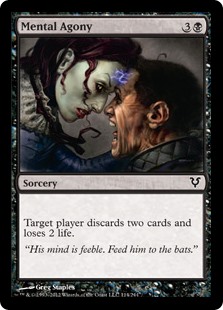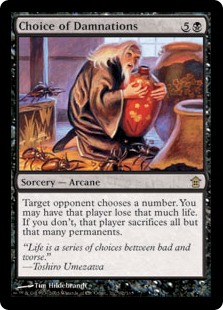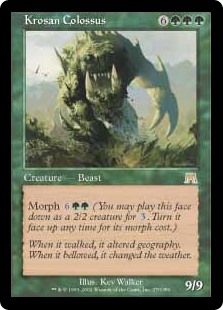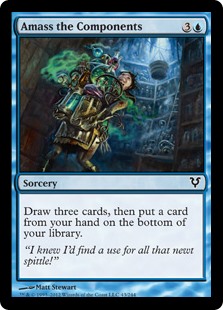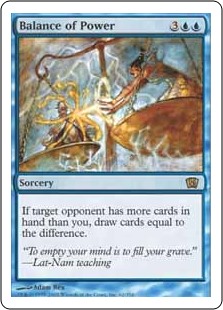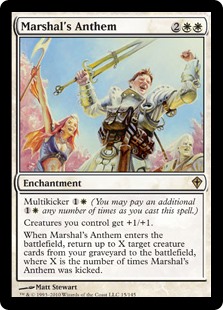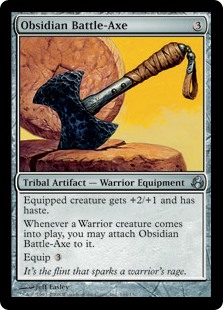Welcome back to the next iteration of this series, wherein I – with some help from a viewer like you – go about crafting a new EDH deck. Specifically, we are focusing on a deck with Alesha, Who Smiles At Death as our Commander. The premise here is to elaborate on how I go about making a deck while also attempting to impart some tips and tricks on Commander deckbuilding in general. That’s the goal anyhow.
At the very least, this series may teach you what not to do.
During the first installment, the decision was made to do a top-down deck approach – one based around the Commander itself. Alesha was chosen, and since she and leverages creature-based strategies, the initial pile of card ideas focused on creatures that either she could do clever things with or those who helped her reprocessing creatures into and out of the graveyard. This led to a massive list of initial creatures to consider trimming down in a very short time span.
Of course, that led to a lot of second guessing, agonizing decision-making, and by the end, the desire to set fire to the whole thing and call it a day.
I told you I was bad at this, right? I really can’t stress that enough.
By the following week, we had curtailed a list of over 350 creatures to about 70, which makes for a good critical mass of creature selections to go into the final deck. After exploring some of the reasons those cards made it, I felt comfortable and content with the resulting choices.
However, much as I’d like, we can’t simply stop with a deck only partially realized. Even in a creature-based EDH deck, creatures alone will rarely make up entirety of it. Other pieces to the engine are required. To best figure out which creatures make the most sense in that engine, then, we have to refine the parameters of what we’re trying to do. That is where we find ourselves today.
Part Three: Refinement Of Concept
When I looked over the creature list, several overarching themes presented themselves. Aside from utilizing powerful Enter The Battlefield triggers, most of them solidified around creature combat in some form. This includes having big creatures, heavy-hitting smaller creatures, and a handful of creatures like Blinding Angel or Raving Dead that you simply don’t want doing combat damage to you.
While my idea of a ‘double damnation’ approach didn’t materialize in the creature list the way I initially envisioned, I still felt there was something to it as a theme. This is all part of a Commander deck’s conception process. Sometimes ideas seem good at first only to be thrown out and others adopted in their place. Other times you dismiss an idea outright and end up circling back to it as you get a better picture of the whole.
I wasn’t ready to completely give up on the premise just yet, but one big problem kept resurfacing. Or I should say a little problem, as the issue I was having was with Alesha herself.
As far as Commanders go, Alesha isn’t very big, and as far as Commanders whose purpose is to attack go, Alesha is down right tiny. Even Shu Yun, the Silent Tempest, a parallel combat-centric legend from the same set has the ability to buff itself quickly, whereas she does not. Alesha may be cheap at three mana, but a 3/2 first strike by itself could run into a host of problems with survivability unless I’m constantly only attacking an opponent who can’t block her. Iroas, God of Victory and / or Dolmen Gate can help with this, but only to a point.
I realized (and accepted) early on that Alesha was going to probably die frequently, and part of my deck build already reflects the need to bring her back repeatedly one way or another. That said, I also need to ensure that she, and by extension some of the creatures that get played or reanimated to her benefit, can also survive a turn or two. Should I want them to, that is.
At the same time, I’d really prefer my opponent didn’t have to make super simple decisions in combat. If I’m running at your wall of Angels or Elementals with a 3/2 first strike and a 2/2 whose ability already resolved, chances are you going to block my creatures with no detriment to you or your army. Likewise, if you have a bunch of small blockers you’d rather not lose, you may opt to simply let my people through for minimal damage.
Now, what if Alesha were a 6/3 first strike? Or a 4/2 double strike? Or a 3/2 first strike with deathtouch? How would that change the player’s decisions on what to do?
Some people will build decks to not give a player options. This is largely up to your own individual play styles and those of your particular play group. Heavy control or one-sided decision-making for a lot of people simply isn’t fun and diminishes the inherent social and political aspects that have come to define Commander as a format. Because of this, I prefer the dynamism of choice in my decks when I can afford to provide them. That is, at least in the cases where either outcome benefits me.
Therefore, it seems reasonable that I should have some means of buffing my creatures. For the most part, that can be done in one of five ways, which are:
- Auras
- Equipment
- Static boosts from Artifact and Enchantments
- Planeswalkers
- Spells
For the purposes of this segment, though, we’re going to focus on just the first three.
Static artifact and enchantment boosts, such as Glorious Anthem are straightforward in their usefulness, providing across the board buffs to all of your creatures. This is particularly handy with Alesha since there will be many times when the creature benefiting will be thrust directly into combat. Yet they are also more limiting since, for the most part, the static boost is the only thing such cards offer.
Auras and Equipment, by contrast, offer a host of specialized combat tricks. However, unless we start mucking about trying to include instant-speed attachment enablers like Vedalken Orrery or Leonin Shikari, anything Alesha brings back won’t be able to immediately benefit from them. And I’d prefer not to do that. Subthemes in a deck are perfectly fine, but in this case that would feel like we’d be getting off track.
Consequently, while some of these cards are certainly worth exploring as options for creatures cast naturally or used on Alesha herself prior to attacking, I desired to significantly limit cards of this kind for consideration. I like the idea of my Alesha deck being nimble in its movement, acting like a sword dancer and being able to change directions fairly easily. To that end, I decided to restrict myself to just 20 cards to look at. I’m envisioning the deck to be slightly more creature-based than what I normally do and am going to need room for options, so I can’t be dwelling too much on this category of cards – especially since we haven’t even touched other useful enchantments or spells yet.
After more browsing, searching and compiling, this particular subset list of the cards netted me about 75 to consider, which I’ve since (painstakingly) whittled down to these 20:
Alesha's Toolbox
Like the creature list that preceded, not every card chosen will make the final list, but using the same approach as before gives us this small pool of cards to work with as things start coming together. As you can see from the finalists, the trimmed-down list is comprised of a mix of all three kinds of cards our search permitted, with five straight buff artifacts or enchantments, five auras, and ten piece of equipment. Funny enough, while this distribution may seem deliberate, it’s actually just the result of which cards were chosen in the end.
Interestingly, when I first started looking at my initial list of permanents, auras made up more than half of my choices. Yet far more of them were cut than anything else. The reasons for their eliminations range wildly, from overall efficacy in the deck, to mana concerns, to having abilities that creatures in the deck may already do equally.
Many people look down on auras, especially in Commander, but I am not one of them – my last deck was Ramses Overdark after all. That said, I came to the conclusion that auras ultimately didn’t make a great fit in large numbers for a deck whose creatures likely won’t have long lifespans. It’s no surprise to that end why three of the five auras in this semi-final list (Angelic Destiny, Flickerform, and Gift of Immortality) all have ways of protecting themselves, or have built-in recursion all their own.
By contrast, most of the static buffs speak for themselves, with Spear of Heliod, Cathar’s Crusade, and In The Web of War all providing useful upgrades for my creatures, while Citadel Siege can either provide useful +1/+1 tokens or equally useful combat manipulation of my opponent’s creatures – especially in offsetting potential (or inevitable) retaliation or for softening up the defenses when going on the attack.
Eldrazi Monument is the only unknown of my five semi-finalists, as I’m not quite sure if it’ll fit the deck. It is an incredibly powerful artifact that would certainly keep my creatures alive, but I’m not quite sure yet if the deck can sustain feeding a creature to it every turn. We’ll see how that fares when things start to materialize more.
Lastly came equipment, which revealed another set of my pattern of behavior manifesting in card choices. This happens with most of us when building a deck, reflecting on personal play styles, so I’m not surprised here. The final equipment choices almost all fell into one of three categories. The first group are efficient equipment pieces that provide useful combat abilities such as first strike, haste, lifelink, or hexproof. (i.e. Basilisk Collar, Sword of Vengeance.) The second group is comprised of the equipment I initially only considered for the deck before I started digging into more options and include those that fuel the deck’s engine by getting land (Sword of the Animist), drawing cards (Infiltration Lens), or being able to fish through my deck when I need specific answers (Sunforger).
The third category evolved as a direct response to my aforementioned worry that too many auras or equipment may be antithetical to the deck. I knew that trying to splice in cards as a means of attaching these permanents to my creatures in combat would be too parasitic to the deck – meaning that those cards would be too specific and reliant on each other to function properly.
However, numerous pieces endeared themselves to me by being able to self-attach under the right circumstances, including Obsidian Battle-Axe, Scythe of the Wretched, and a personal favorite, Deathrender. (Although I was a bit sad to have to cut relative newcomer Hero’s Blade to that same end,)
Each of these helps the deck in their own way, and I’m curious to see whether several of them will pan out. Placing them alongside the creature pool at the moment leads me to think very much that we’re on the right track though.
That said, with a mere five auras to consider for the final deck, none of which are crucial to its operations, we can certainly rule out any chances of Totem-Guide Hartebeest moving from the “Special Slot 71’s” into one of the 70 card spaces. Whether the other two (Auriok Salvagers, and Stoneforge Mystic will either remains to be seen. Admittedly, much of this, especially in the case of the Salvagers, will depend on what other artifacts and non-aura equipment I decide may be worth some attention.
Luckily, that just so happens is what’s in store for us next time. And, as we’ll quickly find out, there’s a lot more to how these card types can assist the deck than simply how big I can make my creatures. Which sort of cards may these be? That, fellow deckbuilders, will have to wait until next time.
Till then, may Alesha find the right weaponry for war.
![]()
Want to talk shop about Building the Dragon Engine, including the cards mentioned? Tell us over on our social media!
Do you have a particular Commander card to suggest for us to shine a future Spotlight on? You can send suggestions to ryan@cardboardrepublic.com

